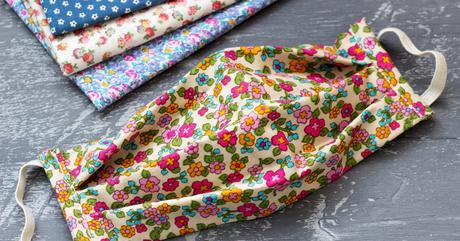
As the COVID-19 coronavirus continues to spread, the CDC is encouraging more people to wear face masks throughout the day. Although masks may be difficult to purchase in some areas, homemade masks are becoming a popular and practical solution to help prevent the disease. Please continue reading to learn how you can make your own face mask, as well as tips for wearing it effectively.
Make Your Own Mask
Please remember to take the following precautions before making masks for yourself or for others:
- Wear a sterile mask while you work. If you do not yet have a mask available then see the video below for tips on making an impromptu no-sew mask.
- Disinfect your machine and work area before beginning.
- Wash your hands thoroughly for at least 20 seconds before you handle the materials. Do not touch your face or any non-disinfected surfaces while you work.
- If you are not using your finished mask immediately then store in an unused and sealed ziplock bag.
You may have heard that Softstar's shoemaking elves have been handcrafting masks for local hospitals over the past few weeks. We are now happy to share a tutorial for a simplified version of our mask that you can make at home with your own sewing machine. Click here to view or download the pattern and instructions:
View/Download Softstar Mask PatternThe CDC released their own tutorials for making a variety of masks, some that require sewing and some that do not. These masks are not shaped to the contours of the face like Softstar's masks, but they are quick and simple instructions that may be ideal for people with little or no sewing skills:
View CDC Mask-Making TutorialsThe CDC also released this video showing how you can quickly create your own face covering using only a piece of fabric and a couple rubber bands... no sewing required!
Best Practices for Effective Use of Face Masks
Our designers have been working with local healthcare professionals to update and refine our mask pattern. In doing so, we we learned a few tips regarding the best practices for using a face mask, which we would like to share with you.
Here are a few DOs and DON'Ts to get the best use from your mask:
- DO have 2-3 masks on hand for your personal use.
- DO make sure a mask is always handy by stashing it in your car, backpack, purse, pocket, etc. Store masks in a new and sealed ziplock bag when not in use.
- DO wash your hands before putting your mask on and before taking it off.
- DO only handle your mask by the straps. As much as possible, avoid touching the fabric that covers your face.
- DO make sure your mask fits secure around the edges of your face. There should be no gaps or sagging open spaces.
- DO make sure your mask is comfortable and allows ample breathability. Everyone's head is unique, so you may need to tweak your mask and adjust the straps to find the right level of comfort for extended wear. See our mask hacks below for ideas.
- DO wash cloth masks after each day of use, and let them dry thoroughly before wearing again. Regular detergent and regular washer cycles are recommended. Avoid bleach and harsh detergents as they may damage the fibers in cloth masks, making them less effective.
- DO look for a mask, or make a mask, with a pocket to allow a paper filter insert for extra protection. Even a coffee filter will work. Replace the filter daily when you wash the mask.
- DO use 2 layers of cotton when making a mask. Heavyweight cotton (thread count of 180 or higher) is recommended. In general, the less light that can shine through the fabric, the better.
- DO consider wearing a mask with fun patterns, especially if you are making your own. Nurses often wear colorful scrubs to help their patients feel at ease. The mask you wear might help spread some cheer during these difficult times.
- DON'T touch the front of your mask. Always handle it by the straps, especially when putting it on or taking it off.
- DON'T wear a wet or damp face mask.
- DON'T flip your mask inside-out or upside-down. Always wear it the same way.
- DON'T wear a mask with gaps or open folds along the edges.
- DON'T wear a mask for several days without washing it.
- DON'T twist ear loops into figure eights to make the mask fit snugger (if your mask uses ear loops). Doing so pulls the fabric up against your nose and mouth, making the mask less effective. If your ear loops are too loose then check our mask hacks below for ways to turn them to an over-the-head closure.
- DON'T take social distancing for granted while wearing your mask! Face masks may give you a false sense of security, which makes it easy to neglect distancing practices. It is still important to stay 6 feet away from other people when you are out and about. Remember that masks only reduce the chances of spreading germs. They do not make you invincible and you can still contract or spread disease while wearing them.
Mask Hacks (Macks?)
Here are a few easy ways you can make your mask more comfortable:
- Replace mask ties with hair bands over your ears
- Do your eyeglasses fog up when you wear your mask? Experiment with sewing or taping paper clips or twist ties to your mask where it sits across the bridge of your nose. These can then be molded to the shape of your bridge for a snugger fit that prevents your breath from escaping upward. Doing so will also help the mask perform more effectively.
- Stitch pleats into the side of your mask if the material is pulled too tightly over your nose and mouth.
- If your mask uses ear loops and you find them to be uncomfortable then you can use paper clips to turn it into an over-the-head closure, or use binder clips to hold it to your hat. See this website for examples.

